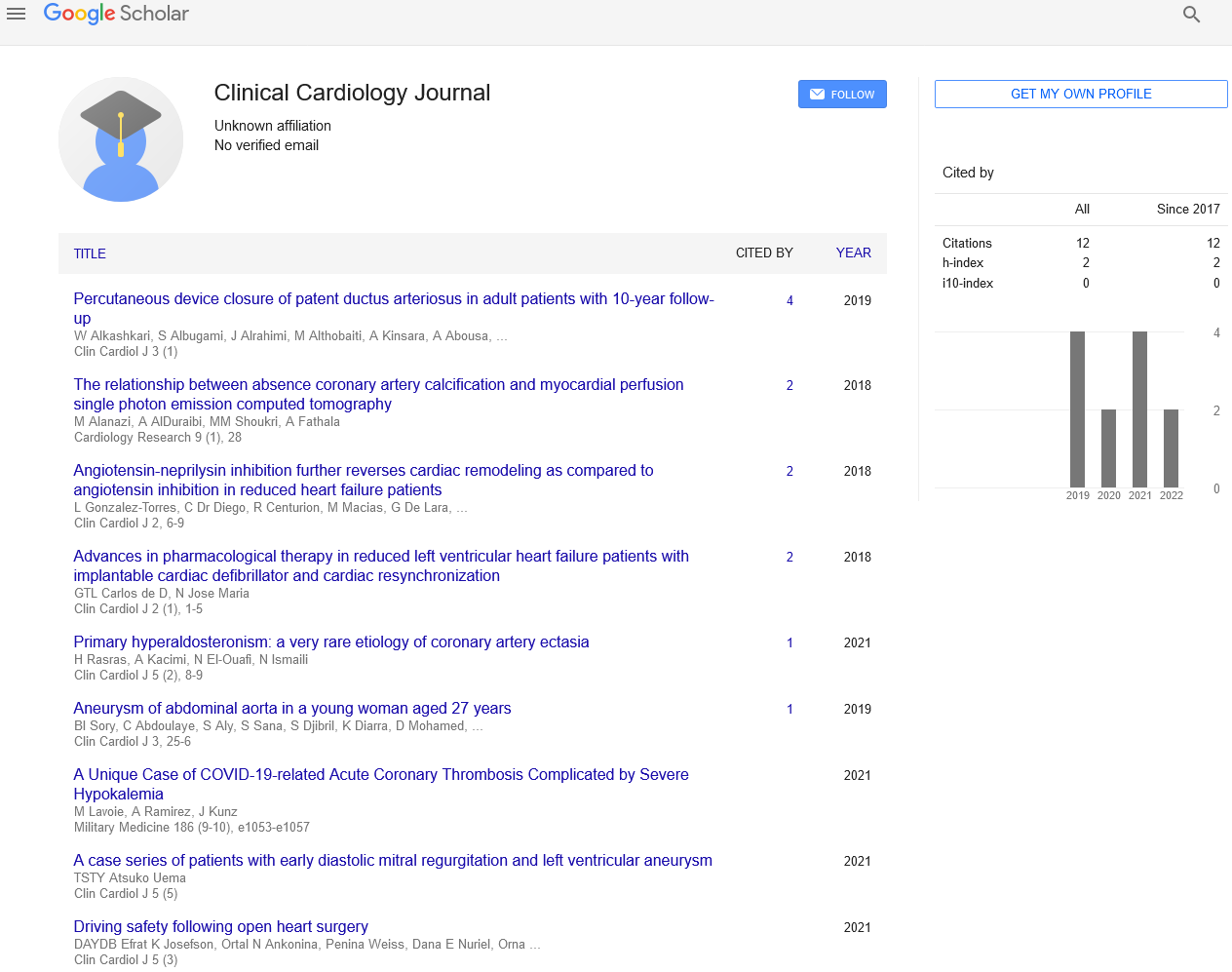An editorial note on complications of acute myocardial infarction in youth
Received: 02-Nov-2021 Accepted Date: Nov 07, 2021; Published: 12-Nov-2021
Citation: Bajaj A. An editorial note on complications of acute myocardial infarction in youth. Clin Cardiol J 2021;5(6):1-1
This open-access article is distributed under the terms of the Creative Commons Attribution Non-Commercial License (CC BY-NC) (http://creativecommons.org/licenses/by-nc/4.0/), which permits reuse, distribution and reproduction of the article, provided that the original work is properly cited and the reuse is restricted to noncommercial purposes. For commercial reuse, contact reprints@pulsus.com
Editorial
Cardiovascular disease is the leading cause of death in the United States, with a mortality rate more than twice that of cancer. Acute myocardial infarction is responsible for more than half of these cardiovascular deaths. The management of acute myocardial infarction patients during and after hospitalisation is examined, with a focus on primary and secondary prevention, patient autonomy, and decision-making. There’s also a look at where treatment for acute myocardial infarction is headed in the future. Cardiovascular disease continues to be a major source of negative outcomes in young people around the world, despite its decline in other age groups.
When compared to older populations, this cohort has a unique risk profile with less typical cardiovascular risk factors. Plaque rupture is still the most common cause of myocardial infarction, although in this age range, distinctive symptoms such plaque erosion, coronary microvascular dysfunction, spontaneous coronary artery dissection, and coronary spasm associated to drug use are more common. The necessity to examine the profile of myocardial infarction in young people is highlighted by the variability of diagnosis and presentation, as well as therapeutic consequences. We searched PubMed for articles published between 1980 and 218 that contained the terms acute myocardial infarction, young, plaque rupture, plaque erosion, spontaneous coronary artery dissection (SCAD), coronary vasospasm, variant or Prinzmetal angina, drug-induced myocardial infarction, myocarditis, coronary embolism, microvascular dysfunction, MINOCA, and myocardial infarction in pregnancy.
We hope to use the information gathered from this search to inform readers about the prevalence, risk factors, presentation, and therapy of acute myocardial infarction in young individuals, as well as specific subgroups with diagnostic and therapeutic problems. In addition, we present a cost-effective technique for managing these difficult patients. Myocardial infarction (MI) is a term for a heart attack caused by plaque formation in the inside walls of the arteries, which reduces blood flow to the heart and injures cardiac muscles owing to a lack of oxygen delivery. Chest pain that radiates from the left arm to the neck, shortness of breath, perspiration, nausea, vomiting, irregular heartbeat, anxiety, exhaustion, weakness, stress, depression, and other causes are all signs of MI. Aspirin, which stops blood clotting, and nitro-glycerin, which treats chest discomfort and oxygen deprivation, are two urgent treatments for MI.
Controlling food, fat, cholesterol, salt, smoking, nicotine, alcohol, and drugs, monitoring blood pressure every week, exercising every day, and losing body weight can all help to prevent heart attacks. Within 3 hours of the commencement of a heart attack, thrombolytic or clot-dissolving medications such as tissue plasminogen activator, streptokinase, or urokinase are injected into the bloodstream to dissolve arterial blockage. To ease pain, medications such as morphine or meperidine can be given. To lower blood pressure and improve the oxygen demand of the heart, nitroglycerin and antihypertensive medications such as beta-blockers, ACE inhibitors, and calcium channel blockers may be utilized. To observe the narrowing of coronary arteries, an ECG, coronary angiography, and X-ray of the heart and blood vessels might be used.
The causes, symptoms, and therapies of MI are discussed in this article. In the absence of abrupt atherothrombotic plaque disruption, acute myocardial infarction (MI) can occur due to increased myocardial oxygen demand and/or reduced supply, a situation known as type-2 myocardial infarction (T2MI). To make the diagnosis, clinical evidence of myocardial ischemia is required, just like with any other MI subtype. Due to the growing sensitivity of cardiac troponin assays, this syndrome is becoming more widely recognized, and it is linked to poor short- and long-term outcomes. Because T2MI is a diverse entity with variable etiologies and triggers, there is limited data to define optimum management techniques. As a result, these patients require specialized care. The lack of a unified definition that can be operationalized with great reproducibility is a key stumbling block. This document summarizes the research on T2MI in order to help doctors better understand its pathobiology, when to use the diagnosis, and how to treat it. It also clarifies the prognosis, exposes information gaps, and makes recommendations for the future.





